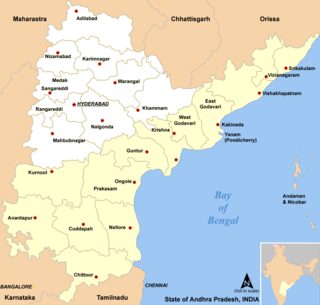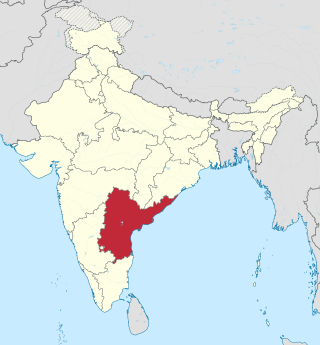
The Bharat Rashtra Samithi, formerly known as Telangana Rashtra Samithi, is an Indian political party which is predominantly active in the state of Telangana and currently the primary opposition party in the state. It was founded on 27 April 2001 by K. Chandrashekar Rao, with a single-point agenda of creating a separate Telangana state with Hyderabad as its capital. It has been instrumental in carrying forth a sustained agitation for the granting of statehood to Telangana.
Telangana Praja Samithi or Telangana Peoples Convention was an Indian political party which fought for statehood for the Telangana region.
The Politics of Andhra Pradesh take place in the context of a bicameral parliamentary system within the Constitutional framework of India. The main parties in the state are the Telugu Desam Party (TDP), Jana Sena Party (JSP), and YSR Congress Party (YSRCP). Other parties that have small presence in the state include the Bharatiya Janata Party (BJP), Indian National Congress (INC), and Left parties, including both Communist Party of India (Marxist) and Communist Party of India (CPI).

Marri Chenna Reddy was an Indian politician active in several states. He was the 6th Chief Minister of Andhra Pradesh from 1978 to 1980 and from 1989 to 1990. He also served as the governor of Uttar Pradesh (1974–1977), governor of Punjab (1982–1983), governor of Rajasthan from February 1992 to May 1993, and governor of Tamil Nadu from 1993 until his death. He was a leader of Indian National Congress Party.
Dr. Mallikarjun Goud was a Union Minister, President of Andhra Pradesh Congress Committee, and six-term member of the Parliament of India. He was the member of 5th Lok Sabha, 6th Lok Sabha, 7th Lok Sabha, 9th Lok Sabha, 10th Lok Sabha, and 11th Lok Sabha of India.

Tulla Devender Goud is an Indian politician from the Telugu Desam Party. He founded the Nava Telangana Praja Party (NTP) to fight for separate statehood for the Telangana region in Andhra Pradesh, but later returned to his parent outfit.

Kothapalli Jayashankar, popularly known as Professor Jayashankar, was an Indian academic and social activist. He was a leading ideologue of the Telangana Movement. He fought for a separate state beginning in 1952. He often stated that unequal distribution of river water was the root cause of the separate Telangana movement. He was the former Vice-Chancellor of Kakatiya University and an activist in the Separate Telangana Movement.

The Telangana movement refers to a movement for the creation of a separate state, Telangana, from the pre-existing state of Andhra Pradesh in India. The new state corresponds to the Telugu-speaking portions of the erstwhile princely state of Hyderabad, which were merged with Andhra Pradesh in 1956, leading to the Mulki Agitations.

Srikrishna Committee on Telangana or the Committee for Consultations on the Situation in Andhra Pradesh (CCSAP) is a committee headed by Justice B. N. Srikrishna to look into the demand for separate statehood for Telangana or keep the State united in the present form, Andhra Pradesh. The committee was constituted by the Government of India on 3 February 2010 and submitted its report on 30 December 2010 to the Ministry of Home Affairs.

Samaikya Andhra Movement was a movement organized to keep the Indian state of Andhra Pradesh united, and to prevent the division of the state - separating the Telangana districts of the state into a separate Telangana state. The movement was supported by government employees, advocates in Coastal Andhra & Rayalaseema regions along with students from 14 universities, various occupational, caste & religious groups of Coastal Andhra & Rayalaseema regions. The last set of protests were triggered after the Congress Working Committee decision to divide the state came to an end after President of India gave nod to Telangana Bill which would make the latter to come into existence from 2 June 2014.

1969 Telangana Agitation was a political movement for the statehood for Telangana region. The first person to raise the issue of Telangana happened in 1968 during October or November. A hunger strike was being carried on by a person named Ravindranath on8 January 1969 in Khammam near the Railway Station. He was on an indefinite fast and his prime demand was to implement Telangana safeguards. One other demand was his insistence on implementation of the Gentleman's agreement. It is a major event in Telangana movement. In the indiscriminate police firing, 369 Telangana students were killed.

The history of the Telangana movement refers to the political and social conditions under which the Telangana region was merged with Andhra State to form the state of Andhra Pradesh and the subsequent demands to reverse the merger to form a new state of Telangana from united Andhra Pradesh.

The Telangana protests 2004-2010 refers to the movements and agitations related to the Telangana movement that took place between the years 2004 and 2010. For the 2004 Assembly and Parliament elections, the Congress party and the TRS had an electoral alliance in the Telangana region to consider the demand of separate Telangana State. However, again in 2006, the then Chief Minister Y. S. Rajasekhara Reddy categorically said that the state would remain united. This again resulted in statewide protests. In 2009, Union Minister of Home Affairs P. Chidambaram announced that the Indian government would start the process of forming a separate Telangana state, pending the introduction and passage of a separation resolution in the Andhra Pradesh assembly after an 11-day fast by K. Chandrashekar Rao. This again resulted in protests across both Andhra and Rayalseema as in a short time of the Home Minister's declaration, MLAs from the Coastal Andhra and Rayalaseema regions submitted their resignations in protest.

The 2012 Telangana protests were a chain of protests which were part of the Telangana movement. The Bharatiya Janata Party, led by state-party president Kishan Reddy, began the 22-day Telangana "Poru Yatra" – a 3,500-kilometre (2,200 mi) journey through 986 villages and 88 assembly constituencies stressing the need for a stance on Telangana stance – on 19 January. Although the tour was successful in reiterating the party's pro-Telangana stance, it did not gain the hoped-for support because of the indifferent attitude of the Telangana Rashtra Samithi and Telangana Joint Action Committee. The TRS' failure to support Reddy's yatra has resulted in increasing differences between the parties. Two assembly by-elections were held that year, the first in March, and the second in June; the BJP won the first, and the YSR Congress Party the second. Protests resumed in August, when K. Chandrashekar Rao gave the centre a two-week deadline to declare statehood.
Jai Andhra movement is a 1972 political movement in support for the creation of Andhra state in the light of injustices felt by the people of the Coastal Andhra and Rayalaseema Regions. This was after the Andhra Pradesh High Court and Supreme Court of India upheld the Mulki rules in existence at the time. This disenfranchised a vast majority of the population of the state from obtaining jobs in their own state capital. In ensuing protests and police firing eight people were killed. Prominent leaders from Andhra Pradesh: Tenneti Viswanadham, Raja Sagi Suryanarayana Raju, Gouthu Latchanna, Jupudi Yegnanarayana, N. Srinivasulu Reddy, B. V. Subba Reddy, Kakani Venkataratnam, Vasantha Nageswara Rao, M. Venkaiah Naidu, Nissankararao Ventakaratnam, Chowdary Satyanarayana, prominent student leaders like K.Sreedhar Rao, and Haribabu from Andhra University, M.S. Raju from Andhra Medical College, and many others participated in the agitation. It was a sequel to the 1969 Telangana movement. Over 400 people sacrificed their lives for the movement. One of the main opinions expressed was "Development is seen only in and around Hyderabad and it is time the coastal districts also develop rapidly".

Virusanolla Srinivas Goud is an Indian politician served as the Minister of Prohibition & Excise, Sports & Youth services, Tourism & Culture and Archaeology of Telangana state. He represented Mahbubnagar constituency as an MLA in the Telangana Legislative Assembly from the Telangana Rashtra Samithi.

The Telangana Pradesh Congress Committee or (TPCC) is the state unit of the Indian National Congress (INC) in the state of Telangana, India. It is responsible for organizing and coordinating the party's activities and campaigns within the state, as well as selecting candidates for local, state, and national elections. The current president of the Telangana PCC is Bomma Mahesh Kumar Goud. The committee has a long history of political influence in the united Andhra Pradesh state, however, it has however, it has historically faced challenges, including fluctuations in electoral support. However, following significant efforts in 2023, the TPCC regained political power in Telangana. With the INC in government in Telangana since December 2023 after the 2023 Telangana Legislative Assembly election, the committee is actively involved in governance and party affairs.
The Indian state of Telangana was founded in 2014. Its territory had formerly been part of Andhra Pradesh. The Telangana movement was instrumental in the creation of the new state, and Bharat Rashtra Samithi, a party which led the Telangana movement after 2001, formed the government in the Telangana Legislative Assembly under its leader K. Chandrashekar Rao as the 1st Chief Minister of the state. The political landscape of Telangana is dominated by the Indian National Congress and the Bharat Rashtra Samithi, with the Bharatiya Janata Party and the All India Majlis-e-Ittehadul Muslimeen being other significant forces.

Andhra Pradesh, retrospectively referred to as United Andhra Pradesh, Undivided Andhra Pradesh, and Combined Andhra Pradesh, was a state in India formed by States Reorganisation Act, 1956 with Hyderabad as its capital and was reorganised by Andhra Pradesh Reorganisation Act, 2014. The state was made up of three distinct cultural regions of Telangana, Rayalaseema, and Coastal Andhra. Before the 1956 reorganisation, Telangana had been part of Hyderabad State, whereas Rayalaseema and Coastal Andhra had been part of Andhra State, formerly a part of Madras Presidency ruled by British India.
The Andhra Pradesh Decentralisation and Inclusive Development of All Regions Act, 2020 is an act of Andhra Pradesh Legislature aimed at the decentralisation of governance in the Indian state of Andhra Pradesh. The bill was proposed by the Government of Andhra Pradesh to establish three capitals at different places in the state namely Visakhapatnam, Amaravati, and Kurnool, which will serve as executive, legislative and judicial capitals respectively.










